The AMD Ryzen Threadripper 1950X and 1920X Review: CPUs on Steroids
by Ian Cutress on August 10, 2017 9:00 AM EST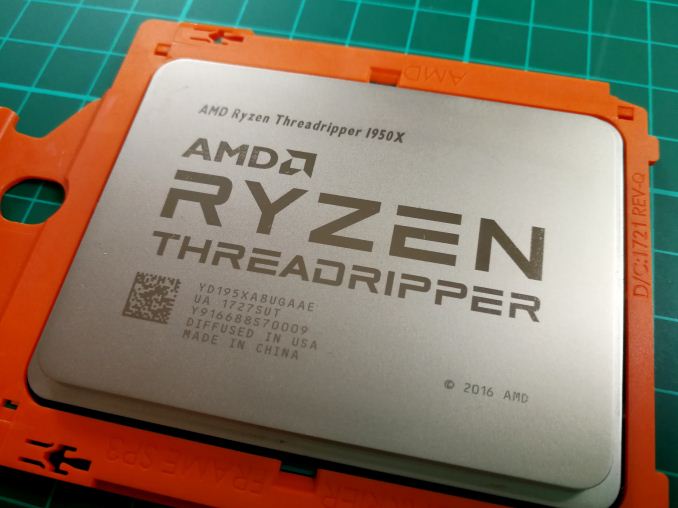
In the early 2000s, we had the battle to high frequencies. The company that could force the most cycles through a processor could get a base performance advantage over the other, and it led to some rather hot chips, with the certain architectures being dropped for something that scaled better. Move on 10-15 years and we are now at the heart of the Core Wars: how many CPU cores with high IPC can you fit into a consumer processor? Up to today, the answer was 10, but now AMD is pushing the barrier to 16 with its new Threadripper processors. We got both of the launch CPUs for review and put them on the grill.
The New World Order
Earlier in the year, AMD launched their new CPU microarchitecture, Zen. This was implemented into the Ryzen series of CPUs, aiming squarely at Intel’s high-end desktop market first. The three members of the Ryzen 7 family all had eight cores with hyperthreading, and scored highly in performance per dollar, achieving performance near comparable Intel processors at half the price (or better). Next came four Ryzen 5 CPUs, competing in price against the quad core i5 parts, and for that price Ryzen 5 had twelve threads, triple that of Core i5. Finally Ryzen 3 hit the ~$120 market against the Core i3s, with double the cores over Intel. We also saw AMD’s EPYC family officially launch into the enterprise space, offering up to 32 cores, and is being rolled out over the next few months as OEMs and customers test and scale their performance.
- The AMD Zen and Ryzen 7 Review: A Deep Dive on 1800X, 1700X and 1700
- The AMD Ryzen 5 1600X vs Core i5 Review: Twelve Threads vs Four at $250
- The AMD Ryzen 3 1300X and Ryzen 3 1200 CPU Review: Zen on a Budget
- Intel's Skylake-SP Xeon versus AMD's EPYC 7000 - The Server CPU Battle of the Decade
Out of the gate today is AMD’s Ryzen Threadripper family, or Threadripper for short. These CPUs take a similar design as the AMD EPYC processors, but for a consumer platform. The first two CPUs are the 1950X and 1920X, with 16 and 12 cores respectively, to be then followed by the 8 core 1900X on August 31st, and the 1920 at sometime unknown. These parts will fit into the LGA-style TR4 socket, containing 4094-pins. This socket is identical (but not interchangeable) to the SP3 socket used for EPYC, and a large step over the 1331-pin PGA-style AM4 socket for the Ryzen 7/5/3 processors.
| AMD Ryzen SKUs | |||||||||
| Cores/ Threads |
Base/ Turbo |
XFR | L3 | DRAM 1DPC |
PCIe | TDP | SRP | Cooler | |
| TR 1950X | 16/32 | 3.4/4.0 | +200* | 32 MB | 4x2666 | 60 | 180W | $999 | - |
| TR 1920X | 12/24 | 3.5/4.0 | +200* | 32 MB | 4x2666 | 60 | 180W | $799 | - |
| TR 1920** | 12/24 | 3.2/3.8 | ? | 32 MB | 4-Ch? | 60 | 140W | ? | - |
| TR 1900X | 8/16 | 3.8/4.0 | +200 | 16 MB* | 4x2666* | 60 | 180W* | $549 | - |
| Ryzen 7 1800X | 8/16 | 3.6/4.0 | +100 | 16 MB | 2x2666 | 16 | 95 W | $499 | - |
| Ryzen 7 1700X | 8/16 | 3.4/3.8 | +100 | 16 MB | 2x2666 | 16 | 95 W | $399 | - |
| Ryzen 7 1700 | 8/16 | 3.0/3.7 | +50 | 16 MB | 2x2666 | 16 | 65 W | $329 | Spire |
| Ryzen 5 1600X | 6/12 | 3.6/4.0 | +100 | 16 MB | 2x2666 | 16 | 95 W | $249 | - |
| Ryzen 5 1600 | 6/12 | 3.2/3.6 | +100 | 16 MB | 2x2666 | 16 | 65 W | $219 | Spire |
| Ryzen 5 1500X | 4/8 | 3.5/3.7 | +200 | 16 MB | 2x2666 | 16 | 65 W | $189 | Spire |
| Ryzen 5 1400 | 4/8 | 3.2/3.4 | +50 | 8 MB | 2x2666 | 16 | 65 W | $169 | Stealth |
| Ryzen 3 1300X | 4/4 | 3.5/3.7 | +200 | 8 MB | 2x2666 | 16 | 65 W | $129 | Stealth |
| Ryzen 3 1200 | 4/4 | 3.1/3.4 | +50 | 8 MB | 2x2666 | 16 | 65 W | $109 | Stealth |
* New information from AMD from our last piece
** Unannounced product, specifications subject to change
Where Ryzen 7 was aiming for Intel’s high-end desktop (HEDT) market share, Threadripper is designed to go above and beyond this, into a ‘super high-end desktop’ market (SHED). The core counts that AMD are releasing with Threadripper were only traditionally seen on Intel’s server line, which features up to 28 cores for a $10000 outlay. By bringing higher-core count parts, with reasonable IPC, frequency, and power numbers, AMD is fudging the line between consumer, prosumer, and enterprise. To compete, Intel announced that their Skylake-X platform will be coming out with 12, 14, 16 and 18 core parts over the next few months.
Similar to Intel’s biggest chips, AMD is aiming Threadripper into the hands of users who want to do everything all the time. For home users, that might mean gaming while streaming (transcoding and uploading in real-time) while also hosting a game server and all other things besides. For prosumers it means video production or compute throughput using several GPUs/FPGAs mixed in with fast storage and networking. The idea is that if the user has something that needs doing, they can also use their system to do other things at the same time and have sufficient CPU grunt, PCIe slots, storage, and DRAM to power it all. Threadripper is, after all, derrived from a design for a server CPU, and accordingly it never strays too far from the high performance-density aspects that have defined servers over the last decade.
New Socket, New Motherboards
Again, similar to Intel’s HEDT platform, AMD is launching the X399 platform alongside Threadripper to provide the necessary tools. The large TR4 socket and all of its pins gives quad-channel memory with two DIMMs per channel, along with up to 60 PCIe lanes for add-in cards (Video cards, NICs, SSDs, etc). These motherboards currently support the two Threadripper CPUs launched today, one more CPU to be launched at the end of the month, and another CPU that has been leaked but not announced (with an unknown release date).
The socket is different to previous AMD sockets, showcasing how much of a step up this is. Rather than a PGA socket with a simple latch system to provide enough force between the pads and pins, the LGA TR4 socket has three Torx screws that should be removed in order – one on the left of the picture above and two on the right. The socket bracket immediately flips open, with a small tray – this tray takes the CPU. All of the Threadripper CPUs will come in this little tray, and there’s no need to take it out of the tray.
Because of the design of the socket and the size of the CPUs, the screw holes for CPU coolers are different as well. As each CPU is currently geared for 180W, AMD recommends liquid cooling at a bare minimum, and will bundle an Asetek CPU bracket with every CPU sold (a Torx screwdriver is also supplied).
The bracket is narrower on one end, which indicates the ‘top’ of the socket in a traditional motherboard shot.
A total of six motherboards from the four main manufacturers should be available on day one, with at least one or two more coming down the pipe. Our own Joe Shields has written an extensive preview of each motherboard to accompany this article.
The crux of the motherboard design will be down to how each of the available IO functions is routed. AMD’s base block diagram is as follows:
AMD's suggested configuration gives 48 lanes from the CPU to the PCIe slots for 4-way SLI/CFX action (16/16/8/8), 12 lanes from the CPU to M.2 slots for 3-way x4 NVMe, and 4 lanes to the chipset. The chipset then would have two gigabit Ethernet ports, a PCIe x4 slot, a PCIe x1 slot, a PCIe x1 for WiFi, SATA ports, USB 3.1 Gen 1 and USB 3.1 Gen 2, and USB 2.0 ports.
At present we expect the X399 motherboards to vary between $249 and $599, depending on their feature set. The motherboard we were sampled for the launch review was ASUS’ X399 ROG Zenith Extreme, which has an MSRP of $549.
Competition
We asked both Intel and AMD to list what they consider would be the ideal competition for the Threadripper processors. Given that Threadripper is a consumer focused product – and interestingly, not really a workstation focused product – AMD expectantly stated that Intel’s current Core i9-7900X, a 10-core processor, is the product available today that best fits that role. A Xeon would be an workstation/enterprise product, which would not be sold in many prebuilt systems that Threadripper customers might want.
Intel surprised me, in saying exactly the same thing. They stated that the Core i9-7900X would be the best fit at the time of Threadripper’s launch. I half-expected them to suggest some form of cheaper 2P option, although when I followed them up as to why they didn’t suggest such a thing, it became obvious for two reasons: firstly, Intel’s Consumer and Intel’s Enterprise divisions are almost different companies with little crossover or insight into the other’s business. There are no unified press relations on this front: ask the consumer team, get the consumer answer. Ask the Enterprise team and they’re more focused on EPYC, not Threadripper. The second reason is that a ‘cheap 2P’ system doesn’t exist when you buy new – most online discussions about cheaper Intel 2P systems revolve around finding CPU bargains from the gray market or resellers.
So the competition is essentially Skylake-X (and a nod to Broadwell-E at a discount). The AMD Threadripper 1950X with 16-cores and 1920X with 12-cores are put up against the Core i9-7900X with 10-cores and the Core i7-7820X with 8 cores. Broadwell’s Core i7-6950X also makes an appearance due to the different microarchitecture. We’ll add in AMD’s Ryzen 7 1800X as a contender as well, and Ryzen 7 1700 as a performance per dollar competitor.
| The Battle | |||||||||
| Cores/ Threads |
Base/ Turbo |
XFR | L3 | DRAM 1DPC |
PCIe | TDP | Cost (8/10) |
||
| AMD | TR 1950X | 16/32 | 3.4/4.0 | +200 | 32 MB | 4x2666 | 60 | 180W | $999 |
| Intel | i9-7900X | 10/20 | 3.3/4.3 | +200 | 13.75 | 4x2666 | 44 | 140W | $980 |
| Intel | i7-6950X | 10/20 | 3.0/3.5 | +500 | 25 MB | 4x2400 | 40 | 140W | $1499 |
| AMD | TR 1920X | 12/24 | 3.5/4.0 | +200 | 32 MB | 4x2666 | 60 | 180W | $799 |
| Intel | i7-7820X | 8/16 | 3.6/4.3 | +200 | 11 MB | 4x2666 | 28 | 140W | $593 |
| AMD | TR 1900X | 8/16 | 3.8/4.0 | +200 | 16 MB | 4x2666 | 60 | 180W | $549 |
| AMD | R7 1800X | 8/16 | 3.6/4.0 | +100 | 16 MB | 2x2666 | 16 | 95 W | $419 |
| AMD | R7 1700X | 8/16 | 3.4/3.8 | +100 | 16 MB | 2x2666 | 16 | 95 W | $350 |
| AMD | R7 1700 | 8/16 | 3.0/3.7 | +50 | 16 MB | 2x2666 | 16 | 65 W | $291 |
The key here is that Threadripper has more cores and more PCIe lanes at the same price, with a lower turbo but a higher base frequency, at slightly more power for similar platform costs. It’s going to be an interesting battle.
Pages In This Review
- 1: AMD Ryzen Threadripper 1950X and 1920X
- 2: Feeding the Beast and CPU Top Trumps
- 3: Silicon, Glue, & NUMA Too
- 4: AMD’s Solution to Dual Dies: Creator Mode and Game Mode
- 5: Test Bed and Setup
- 6: Benchmark Overview
- 7: Benchmarking Performance: CPU System Tests
- 8: Benchmarking Performance: CPU Rendering Tests
- 9: Benchmarking Performance: CPU Web Tests
- 10: Benchmarking Performance: CPU Encoding Tests
- 11: Benchmarking Performance: CPU Office Tests
- 12: Benchmarking Performance: CPU Legacy Tests
- 13: Gaming Performance: Civilization 6 (1080p, 4K, 8K, 16K)
- 14: Gaming Performance: Ashes of the Singularity Escalation (1080p, 4K)
- 15: Gaming Performance: Shadow of Mordor (1080p, 4K)
- 16: Gaming Performance: Rise of the Tomb Raider (1080p, 4K)
- 17: Gaming Performance: Rocket League (1080p, 4K)
- 18: Gaming Performance: Grand Theft Auto V (1080p, 4K)
- 19: Power Consumption and Efficiency
- 20: Analyzing Creator Mode and Game Mode
- 21: Conclusions and Final Words
Additional Review Notes
Due to circumstances beyond our control, this review has no Skylake-X gaming data. At the time of our SKL-X review, it was throwing up some issues and so we aimed to test at a later date. We ran some more data using the latest BIOS and a more stringent cooling setup, then when Threadripper arrived we packed the SKL-X away and Threadripper took the phsyical place of SKL-X in the lab. Having had time to look back at our SKL-X results and now process them, we had one CPU+GPU combo that seemed to perform as expected but the rest were still erroneous. Once this review is out of the way and a couple of mini-projects, we're going to update the X299 motherboard with a new one and knuckle down to find this issue, as it appears to be BIOS/firmware related.


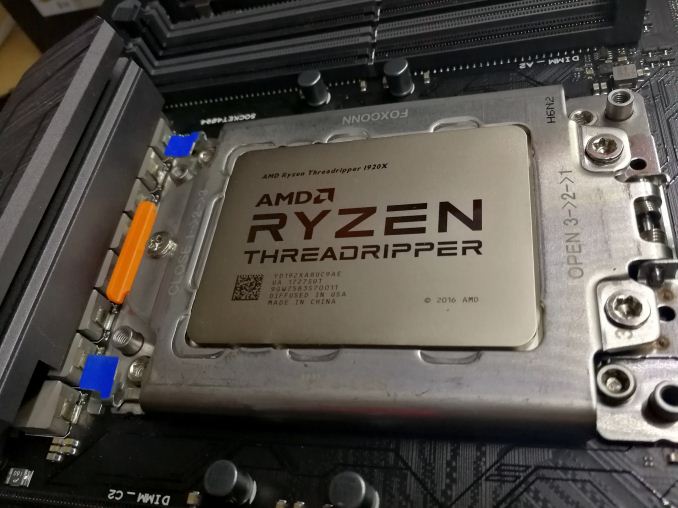
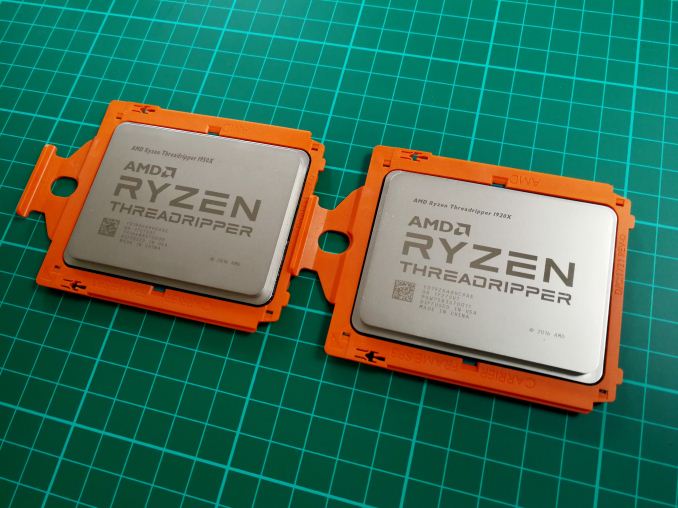
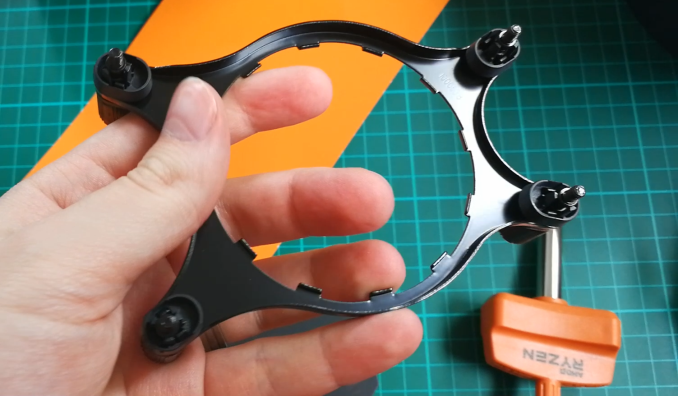
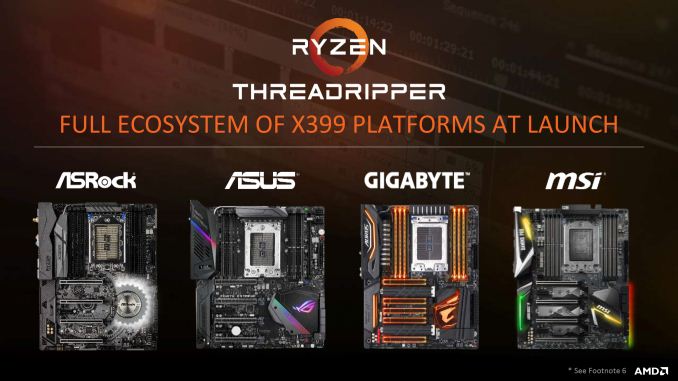
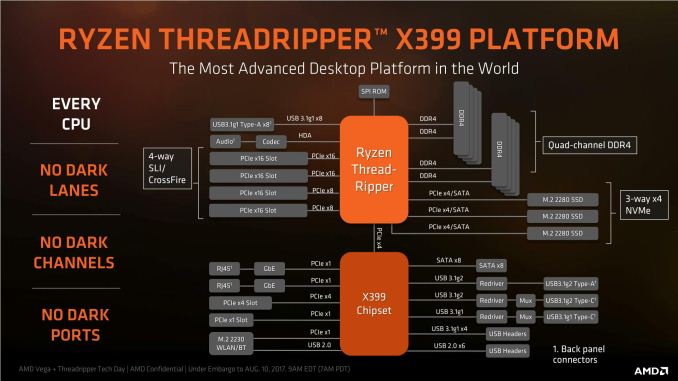








347 Comments
View All Comments
nitin213 - Thursday, August 10, 2017 - link
Thanks for your reply. Hopefully the test suite can be expanded as Intel's CPUs probably also move to higher core count and IO ranges in future.and i completely understand the frustration trying to get a 3rd party to change their defaults. Cheers
deathBOB - Thursday, August 10, 2017 - link
It's clear to me . . . Ian is playing both sides and making out like a bandit! /sFreckledTrout - Thursday, August 10, 2017 - link
Ian can we get an updated comments section so we can +/- people and after x number of minuses they wont show by default. I'm saying this because some of these comments(the one in this chain included) are not meaningful responces. The comments section is by far the weakest link on Anantech.Nice review btw.
mapesdhs - Thursday, August 10, 2017 - link
toms has that, indeed it's kinda handy for blanking out the trolls. Whether it's any useful indicator of "valid" opinion though, well, that kinda varies. :D (there's nowt to stop the trolls from voting everything under the sun, though one option would be to auto-suspend someone's ability to vote if their own posts get hidden from down voting too often, a hands-off way of slapping the trolls)Given the choice, I'd much rather just be able to *edit* what I've posted than up/down-vote what others have written. I still smile recalling a guy who posted a followup to apologise for the typos in his o.p., but the followup had typos aswell, after which he posted aaaaagh. :D
Ian.
Johan Steyn - Thursday, August 10, 2017 - link
Ian thanks for at least responding, I appreciate it. Please compare your review to sites like PCPer and many others. They have no problem to also point out the weak points of TR, yet clearly understand for what TR was mostly designed and focus properly on it and even though they did not test the 64 PCI lanes as an example, mention that they are planning a follow-up to do it, since it is an important point. You do mention these as well, but could have said more than just mention it by the way.Look at your review, most of it is about games. Are you serious?
I have to give you credit to at least mention the problems with Sysmark.
Let me give you an example of slanted journalism, When you do the rendering benchmarks, where AMD is known to shine, you only mention at each benchmark what they do etc, and fail to mention that AMD clearly beats Intel, even though other sites focus more ons these benchmarks. In the one benchmark where Intel get a descent score, you take time to mention that:
"Though it's interesting just how close the 10-core Core i9-7900X gets in the CPU (C++) test despite a significant core count disadvantage, likely due to a combination of higher IPC and clockspeeds."
Not in one of the rendering benchmarks do you give credit to AMD, yet you found it fitting to end the section of with:
"Intel recently announced that its new 18-core chip scores 3200 on Cinebench R15. That would be an extra 6.7% performance over the Threadripper 1950X for 2x the cost."
Not slanted journalism? At least you mention "2x the cost," but for most this will not defer them in buying the monopoly.
After focussing so much time on game performance, I am not sure you understand TR at all. AMD still has a long way to go in many areas. Why? Because corrupt Intel basically drove them to bankruptcy, but that is a discussion for another day. I lived through those days and experienced it myself.
Maybe I missed it, but where did you discuss the issue of memory speed? You mention in the beginning of memory overclock. Did you test the system running at 3200 or 2666? It is important to note. If you ran at 2666, then you are missing a very important point. Ryzen is known to gain a huge amount with memory speed. You should not regard 3200 as an overclock, since that is what that memory is made for, even if 2666 is standard spec. Most other sites I checked, used it like that. If you did use 3200, don't you think you should mention it?
Why is it that your review ends up meh about TR and leave you rather wanting an i9 an almost all respects, yet most of the other site gives admiration where deserved, even though they have criticism as well. Ian I see that you clearly are disappointed with TR, which is OK, maybe you just like playing games and that is why you are so.
It was clear how much you admire Intel in your previous article. You say that I gave no examples of slanted journalism, maybe you should read my post again. "Most Powerful, Most scalable." It is well known that people don't read the fine print. This was intentional. If not, you are a very unlucky guys for having so many unintended mishaps. Then I truly need to say I am sorry.
For once, please be a bit excited that there is some competition against the monopoly of Intel, or maybe you are also deluded that they became so without any underhanded ways.
By the way, sorry that I called you Anand. I actually wanted to type Anandtech, but left it like it. This site still carries his name and he should still take responsibility. After I posted, I realised I should have just checked the author, so sorry about that.
vanilla_gorilla - Thursday, August 10, 2017 - link
"Intel recently announced that its new 18-core chip scores 3200 on Cinebench R15. That would be an extra 6.7% performance over the Threadripper 1950X for 2x the cost."How do you not understand that is a dig at Intel? He's saying you have to pay twice as much for only a 6.7% improvement.
smilingcrow - Thursday, August 10, 2017 - link
The memory speed approach taken was clearly explained in the test and was stated as being consistent with how they always test.I don't take issue with testing at stock speeds at launch day as running memory out of spec for the system can be evaluated in depth later on.
Johan Steyn - Friday, August 11, 2017 - link
That is just rubbish. Threadripper has no problem with 3200 memory and other sites has no problem running it at that speed. 3200 memory is designed to run 3200, why run it at 2666? There is just no excuse except being paid by Intel.Maybe then you can accuse other sites of being unscientific?
fanofanand - Tuesday, August 15, 2017 - link
Anandtech always tests at JDEC, regardless of the brand.Manch - Friday, August 11, 2017 - link
""Intel recently announced that its new 18-core chip scores 3200 on Cinebench R15. That would be an extra 6.7% performance over the Threadripper 1950X for 2x the cost."Not slanted journalism? At least you mention "2x the cost," but for most this will not defer them in buying the monopoly."
You call Intel the monopoly and call him out for not wording the sentence to dissuade people from buying Intel. Who has the bias here? If he was actively promoting Intel over AMD or vice versa, you'd be OK with the latter, but to do neither. He's an Intel shill? Come on. That's unfair. HOW should he have wrote it so it would satisfy you?
FYI Anand is gone. He's NOT responsible for anything at Anandtech. Are you going to hold Wozniak's feet to the fire for the lack of ports on a Mac too?